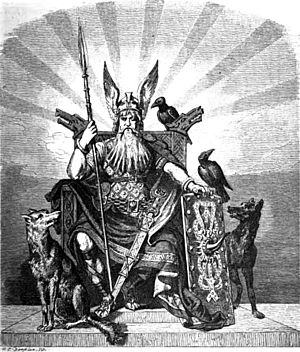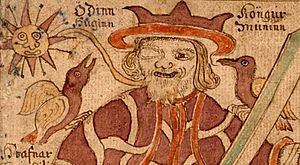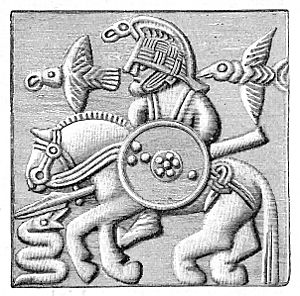Huginn and Muninn facts for kids
In Norse mythology, Huginn (meaning "thought") and Muninn (meaning "memory" or "mind") are two special ravens. They fly all over the world, called Midgard, and bring important news to the god Odin.
Stories about Huginn and Muninn are found in old texts. These include the Poetic Edda and Prose Edda, which were written down in the 1200s. They are also mentioned in Heimskringla and in poems by skalds (Viking poets). Sometimes, their names are spelled in a more modern way as Hugin and Munin.
In the Poetic Edda, Odin, who is sometimes in disguise, says he worries about his ravens. He fears they might not come back from their daily flights. The Prose Edda explains that Odin is known as Hrafnaguð, which means "raven-god." This is because he is so closely connected to Huginn and Muninn. In these stories, the ravens sit on Odin's shoulders. The Heimskringla even says that Odin gave Huginn and Muninn the ability to speak.
Many old objects show Odin with one or both of his ravens. These include golden bracteates (old coins or medals), helmet plates from the Vendel era, and bird-shaped brooches. Some Viking Age items also show a man with a mustache wearing a helmet, which people believe is Odin. A part of the 10th or 11th century Thorwald's Cross also shows a large bird on a man's shoulder. The ravens' job as Odin's messengers is linked to old shamanic practices and the general meaning of ravens among the Germanic peoples.
Contents
Stories About Huginn and Muninn

The ravens are mentioned in several old Norse writings. These stories help us understand their role.
In the Poetic Edda
In the poem Grímnismál, the god Odin (who is pretending to be someone else) tells a young prince about his animal friends. He talks about his wolves, Geri and Freki. Then, he says that Huginn and Muninn fly across the whole world, Midgard, every day. Odin says he worries that Huginn might not return, but he worries even more about Muninn.
Here is what the poem says:
- Hugin and Munin fly each day
- over the spacious earth.
- I fear for Hugin, that he come not back,
- yet more anxious am I for Munin.
In the Prose Edda
In the book Gylfaginning, a figure named High explains to a disguised king that Huginn and Muninn sit on Odin's shoulders. The ravens tell Odin everything they see and hear. Odin sends them out at dawn, and they fly all over the world. They return at dinner-time, bringing Odin lots of news. Because of this, Odin is called the "raven-god." The poem from Grímnismál is also quoted here.
In Heimskringla
The book Ynglinga saga tells a story about Odin's life. It says that Odin had two ravens and gave them the power to speak. These ravens flew everywhere and brought him information. This made Odin "very wise in his lore."
In the Third Grammatical Treatise
An old poem in this book mentions the ravens flying from Odin's shoulders. It says Huginn looks for hanged men, and Muninn looks for dead bodies.
Archaeological Discoveries
Many ancient objects found by archaeologists seem to show Odin with his ravens.
Golden Bracteates
Golden bracteates from the 400s and 500s CE often show a person above a horse, holding a spear, with one or two birds. People believe this person is Odin, with Huginn and Muninn. Sometimes, a bird is shown near the person's ear or the horse's ear, just like in the Prose Edda description. These bracteates have been found in Denmark, Sweden, Norway, and England. Some experts think these pictures might show Odin and his ravens healing a horse. This could mean the birds were not just his battle friends but also helped him with healing animals.
Vendel Era Helmet Plates
Helmet plates from the 500s or 600s, found in a grave in Sweden, show a helmeted figure. This figure is holding a spear and shield, riding a horse, and has two birds with him. This picture is thought to be Odin with his ravens.
Bird-shaped Brooches
A pair of matching bird-shaped brooches from Bejsebakke in Denmark might show Huginn and Muninn. These brooches have mask designs and animal heads on their backs and feathers. Their strong beaks and fan-shaped tails suggest they are ravens. They were meant to be worn on each shoulder, which makes people think of Odin's ravens. The masks on the ravens might even be pictures of Odin himself.
Oseberg Tapestry Fragments
Parts of the Oseberg tapestry fragments, found in a Viking Age ship burial in Norway, show two black birds flying over a horse. These birds are thought to be Huginn and Muninn.
Ribe Moulds
In Ribe, Denmark, archaeologists found Viking Age metal casting moulds. These moulds show a man with a mustache wearing a helmet with two head ornaments. It is believed these ornaments are Huginn and Muninn, and the man is Odin. Similar pictures have been found wherever the Vikings traveled.
Thorwald's Cross
A part of Thorwald's Cross, a runestone on the Isle of Man, shows a bearded man holding a spear. A large bird is on his shoulder. This bird might be Huginn or Muninn. This scene is sometimes thought to show Odin with a raven, being attacked by the wolf Fenrir during Ragnarök.
Odin from Lejre Figurine
In 2009, a small silver statue called "Odin from Lejre" was found in Lejre, Denmark. It shows a person sitting on a throne with animal heads. Two birds are on either side of the throne. The museum believes this is Odin on his throne Hliðskjálf, with Huginn and Muninn.
See also
 In Spanish: Hugin y Munin para niños
In Spanish: Hugin y Munin para niños
- Hrafnsmál, an old poem about a conversation between a valkyrie and a raven
- List of names of Odin, which includes names like Hrafnaguð (raven god)
- Valravn, a mythical "raven of the slain" in Danish folk songs
- Hugin and Munin (Marvel Comics), characters in Marvel Comics based on the Norse originals
- Yatagarasu, a three-legged crow in Japanese Shinto mythology



